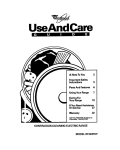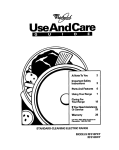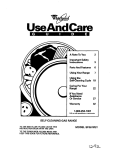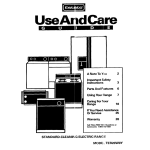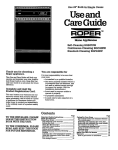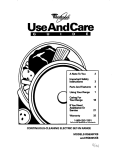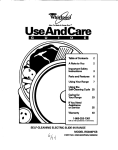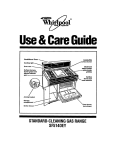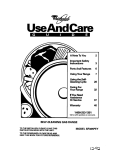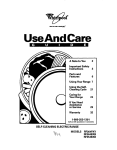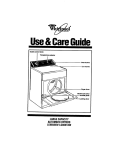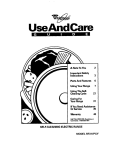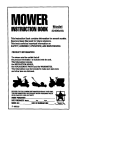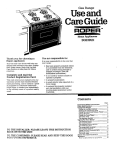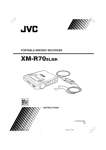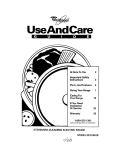Download Whirlpool RF36OOXY User's Manual
Transcript
UseAndCam ANoteToYou 2 lmporta~safety Instructions 3 PartsAndFeatures 6 Using Your Range 7 Using The SeffCleaning Cycle 19 Caring For Your Range 22 If You Need Assistam 26 orWarranty 32 ~T~REE~~onsor SELF-CLEANING ELECTRIC RANGE MODEL RF36OOXY A Note To You Thank you for buying a Whirlpool appliance. You have purchased a quality, wo&c&ss home appliance. Years of engineering experience have gone into its manufacturing. To ensure that you will enjoy many years of trouble-free operation, we have developed this Use and Care Guide. lt is full of valuable information on how to operate and maintain your appliance properly and safely. Please read it carefully. Also, please complete and mail the Cwnership Registration Card provided with your appliance. Your safety is important to us. This guide contains safety symbols and statements. Please pay special attention to these symbols and folbw any instructions given. Here is a brief explanation of the use of each symbol. This symbol will help alert you to such dangers as personal injury, burns, fire and electrical shock. This symbol will help you avoid actions which could cause product damage (scratches, dents, etc.) and damage to your personal property. Our Consumer is TOLL-FREE, number, Assistance Center 24 hours a day. l-800-253-1301, ff you ever have a question concerning your appIiance’s operation, or if you need service, feel free to call our Consumer Assistance Center for help. When calling, you will need to know your appliance’s complete model number and serial number. You can find this information on the model and serial number plate (see diagram on page 6). For your convenience. we have included a handy place below for you to record these numbers, the purchase date from the sales slii and your dealer’s name and telephone number. Keep this hook and the sales slip together in a safe place for future reference. Model Number Dealer Name Serial Number Dealer Phone Purchase Date 2 Important Safety Instructions To reduce the risk of fire, electrical shock, injury to rsons, or damage when using the range, follow r asic precautions, including the following: General 4ead all instructions before using the range. l Install or locate the range only in accordance with the provided Installation Instructions. It is recommended that the range be installed by a qualified installer. The range must be properly connected to electrical supply and grounded. l WARNING: To reduce the risk of ti ping of the appliance, the app Piance must be secured by a properl installed anti-tip bracket. f!o check if the bracket is installed properly, see The anti-tip bracket” on page 18. @CAUTION: Do not store things children mi ht want above the range. Chil iI ren could be burned or injured while climbing on it. l Do not leave children alone or unattended in area where the range is in use. They should never be allowed to sit or stand on an part of the range. They could i e burned or injured. l Do not operate the range if it is damaged or not working properly. @Donot use the range for warming or heatin the room. Persons could be %urned or injured, or a fire could start. 4Jse the range only for its-in- . t;;f;tl use as described In this . ~DO not touch surface units, areas near units, heating elements or interior surfaces of become hot enou h to cause burns. Durin an CPafter use, do not touch, or9 et clothing or other flammable matenals contact surface units, areas near units, heatin elements or interior surfaces 07 oven until they have had sufficient time to cool. Other surfaces of the range may become hot enough to cause burns; such as, the oven vent opening, the surface near the vent opening, the cooktop and the oven door. @Donot wear loose or hanging garments when using the range. The could ignite if they touch a hoYsurface unit and you could be burned. continued on next page 3 @Useonly d potholders. Moist or damp po7 holders on hot surfaces may result in burns from steam. Do not let potholder touch hot heating elements. Do not use a towel or bulk cloth foOnr;repotholder. It coul dycatch l Check to be sure lass cook- ing utensils are sa3e for use on the range. Only certain types of glass, glass-ceramic, ceramic, earthenware or other glazed utensils are suitable for cooktops without breaking due to the sudden change in temperature. *Keep range vents unobstructed. @Neverleave surface units @Donot heat unopened containers. They could explode. The hot unattended at high heat settin s. A boilover could result contents could cause burns and an%cause smokin and container particles could cause greqeiy spillovers t I?at may injury. . @Donot store flammable materials on or near the range. The fumes can create an explosion and/or fire hazard. When usincr the cookto~ *Turn pan handles inward, but .Make sure the reflector bowls not over other surface units. are in place during cooking. This will help reduce the Cookin without reflector bowls chance of burns, i niting of may suk ject the wiring and flammable materia9s, and components underneath them to spills due to bumping of the damage. pan. .Do not line reflector bowls with aluminum foil or other liners. When using the oven Improper installation of these @Always position oven rack(s) liners ma result in a risk of in desired location while oven electric s i! ock or fire. is cool. If a rack must be re‘Select a pan with a flat bottom moved while oven is hot, do that is about the same size as not let potholder contact hot the surface unit. If pan is smaller heating element in oven. than the surface unit, some of *Use care when opening oven the heating element will be door. Let hot air or steam exposed and may result in the escape before removing or I nrtrng of clothing or potholders. replacing food. 8 orrect pan size also improves cookng efl iciency. 4 Grease l Grease is flammable. Do not allow grease to collect around cooktop or in vents. Wipe spillovers immediately. .Do not use water on grease fires. Never pick up a flaming pan. Smother flamin pan on range b coverin WI9h a wellfitted Iidy, cookie s7l eet or flat tray. Flaming rease outside of an can be eii in uished with 1aking soda or, iBavailable, a multipurpose dry chemical or foam-type extinguisher. Care and cleaning 6mall amounts of formaldehyde and carbon monoxide are iven off in the Self-Cleaning cyc9e from fiberglass insulation and food decomposition. Si nificant exposure to these subs9antes can cause cancer or reproductive harm. Exposure can be minimized by venting with a hood or o en window and wiping ou Pexcess food spills pnor to self-cleaning. ADOnot use oven cleaners. No commercial oven cleaner or oven liner rotective coating of any kind s I!ould be used in or around any part of the oven. aBefore self-cleaning the oven., remove broiler an, broiler rid, oven racks an cf other utensl9s. Do not use your oven to clean miscellaneous parts unless you are instructed to do so in this Use and Care Guide. ADOnot soak removable heating elements in water. The element will be damaged and shock or fire could result. @Donot clean door heat seal. It is essential for a good seal. Care should be taken not to rub, damage or move the seal. Clean only parts recommended in this Use and Care Guide. .Do not repair or replace any part of the range unless specifically recommended in this manual. All other servicing should be referred to a qualified technician. l Disconnect the electrical supply before servicing the range. - SAVE THESE INSTRUCTIONS - PartsAnd Features This section contains captioned illustrations of your range. Use them to become familiar with the kxation and appearance of all parts and features. Antl-tlp bracket (on wall bahlnd 0entrol psnsl) I u - Oven wnt Plug-In surfi~ce unlt with one::Etmz y -LOdtlt3VW ModOiU4sMlsI numbsrplste - f Broil element 1 saka element Renlovabk storsge drawer Control LOWfront Control knob I panel Left rear Control Automatk MEALTIMER’ olookMnut0 stop Urn0 I tempsrature oontrol knob , start surfa& time 6 henung lndkstor light lWlng lndkntor light Suriaos unlt marker own aalytor Rl;lht mer control knob Fll;ht front control knob Using Your Range In This Section Brdllng ---.........7 Energy oavlng ups __....” -...-..-.. “---“.-....-.“~.1o Using alumlnum foil for baking ...._-- -.. . . ..-....... - _-....-. -.-..--13 Brolllng tlpa -..................... -...-.-....--.14 PodUonlng mdm and pm8 -.-.......---..@ For best air drculath Paw Pago Udng the rutface unita I-.....-.. .-- Betting the dock --..-.“.“...“-.-...““““-“. 10 Using thewtamatk 11 The own vent ---....-- “..I .I.. -.15 YEALTlMER’dock..-18 “..,“.....“““...““17 Using the Ylnute Timer -..---.---...-11 The storage dmww u................e....-............ -18 BaUnghoa8Ung The antl-Up brwht ..-.--._ - .....---.---12 ll-....ll-l.-..l. -....lE Adjusting the oven temperature control -..-13 To obtain the best cooking results possible, you must operate your range properly. This section gives you important information for efficient and safe use of your range. Using the surface units Coritrol knobs must be pushed In before turnlng them to a setting. They can bs set anywhere between HI and OFF. Surface unit markers The solid dot in the surface unit marker shows which surface unit is turned on by that knob. Surface heating indicator light The SURFACE HEATING Indicator Liiht on the control panel will glow when a surface unit is turned on. Burn and Fire Hazard Be sure all control knobs are turned to OFF and all indicator lights are OFF when you are not cooking. Someone could be burned or a fire could start if a surface unit is accidentally left ON. Until you get used to the settings, uss the foliowing as a guide. For best resufts, start axking at the high settings; then turn the control knob down to continue cooking. SEIllNG Hi RECOMMENDED USE To start fcuxfs cooking. l To bring liquids to a boil. Medium-high l To hold a rapid boil. l To fry chicken or pancakes. Medium l For gravy, pudding and icing. l To cook large amounts of vecetables. Medium-low l To keep food cooking after I starting it on a higher setting. I LO l To keep food warm until ready to serve. Cookware l l l l Handles should be made of a sturdy, heatresistant material and be securely attached to the pan. Do not leave an empty utensil, or one which has boiled dry, on a hot surface unit. ft can overheat and may damage the utensil or surface unit. Do not use canners, woks and specialty utensils with rounded, warped, ridged or dented bottoms. These could cause severe overheating which damages the utensil and/ or surface unit. Product Damage Hazard fl a surface unit stays red for a long time, the bottom of the pan is not flat enough or is too small for the surface unit. Prolonged usage of incorrect utensils for long periods of time can resuft in damage to the surface unit, cooktop, wiring and surrounding areas. To prevent damage, use correct utensils, start cooking on HI and turn control down ?o continue cooking. tips There is no one brand of cooking utensil that is best for all people. Knowing something about pan materials and construction will help you select the right cooking utensils for your needs. l Use only flat-bottomed utensils that make good contad with the surface units. To check the flatness of a utensil: - Turn it over and check the bottom of the pan by placing a ruler across it. - Rotate the ruler in all directions. There should be no gaps between the pan and the ruler. NOTE: Woks, canners and teakettles with flat bottoms suitable for use on your cooktop are now available in most houseware stores or departments. l The pan should have straight sides and a tightfiiing lid. l Choose medium to heavy gauge (thickness) pans that are fairly lightweight. Remember that a very heavy pan will be even heavier when filled with food. l The pan material (metal or glass) affects how fast heat transfers from the surface unit through the pan material and how evenly heat spreads over the pan bottom. .1 Home canning information To protect your range: l Use flat-bottomed canners for best resutts. Do not use canners with dented or ridged (porcelain enamel-ware) bottoms. They do not make good contact with the surface unit and cause severe overheating which damages the C-k@l For best results, use the largest surface unit. Also, use a canner which can be centered over the surface unit. Large diameter canners, if not properly centered, trap heat and can cause damage to the cooktop. l Do not place canner on two surface units at the same time. Excessive heat build-up will damage the cooktop. l Start with hot water. This reduces the time the amtrol is set on high. Reduce heat setting to lowest position needed to keep water boiling. l Keep reflector bowls clean for best heat reflection. l To prolong the life of the elements: - Prepare small batches at a time. - Do not use elements for canning all day Positioning racks Optional canning kit The large diameter of most water-bath or pressure canners combined with high heat settings for bng periods of time can shorten the liie of regular surface units and cause damage to the cooktop. ff you plan to use the cooktop for canning, we recommend the installation of a Canning Kit. Order the kii (Part No. 242905) from your Whirlpool dealer or authorized Whirlpools” se&a company. and pans For baking/roasting with one rack, the rack should be placed so the top of the food will be centered in the oven. Always leave at least 1’12 to 2 inches (4-5 cm) between the sides of the pan and the oven walls and other pans. For proper cooking, follow these gukielines for specifk foods: l Angel and bundt cakes, yeast breads, frozen pies, large roasts and turkeys-plaoe rack on lowest level. l Casseroles, muffins, most quick breads and meats-place rack on second or third level from bottom. l Cookies, bhcuits. cakes and non-frozen piesplace rack on second or third level from bottom. When baking on two racks, arrange racks on bottom and third level from bottom. NOTE: For recommended rack placement when broiling, see a reliable cookbook. Personal injury Hazard Always position oven rack(s) in desired location before turning oven on. Be sure the rack(s) is level. l If rack(s) must be moved while oven is hot. use potholders or oven mitts to protect hands. Failure to follow the above precautions may result in personal injury. l For best air circulation Hot air must circulate around the pans in the oven for even heat to reach all parts of the oven. l Place the pans so that one is not directly over the other. l Allow 11X-2inches (4-5 cm) of space around each pan and between pans and oven walls. l Use onfy one cookie sheet in the oven at one time. Use the following as a guide to determine where to place the pans. One pan Place in the center of the oven rack. Two pans Place in opposite comers of the oven rack. Three or four pans Place in opposite comers on each oven rack. Stagger pans so no pan is directly over another. NOTE: “Oven peeking’ may cause heat bss, longer cooking times and unsatisfactory baking or roasting results. Use a reliable kitchen timer to keep track of the cooking time. Using aluminum foil for baking Use aluminum foil to catch spillovers from pies or casseroles. l Place the foil on the oven rack below the rack with the food. The foil shoufd have the edges turned up and be about 1 inch (3 cm) larger all around than the dish holding the food. . Do not cover the entire rack wlth aluminum foil. ff will reduce air circulation and cause poor cooking resuh. l Do not line oven bottom or entire oven rack with foil or other liners. Poor baking will result. Eiectricsl Shock and Firs Hazard Do not allow foil to touch the heating elements because it will damage them and could result in shock or fire hazard. 10 Setting the clock Push in and turn the Minute Timer Knob to set the dock. 1. Push In Minute llmer Knob and turn clockwW until clock shows the coned time of day. 2. Let the Minute Timer Knob pop out. Turn dockwise until Minute Timer hand points to OFF. The clock setting will change If you push In the knob when tumlng. Using the Minute Timer The Minute Timer does not start or stop the oven. lt works like a kitchen timer. Set it in minutes up to an hour. You will hear a buzzer when the set time is up. Do not push In the knob when setting the Minute Timer. 1. Wlthout pushlng lt In, turn the Minute Timer Knob counterclockwise until the timer hand passes the setting you want. 2. Wlthout pushlng lt In, turn the knob back to the setting you want. When the time la up, a buzzer will sound. To stop the buzzer, turn the Minute Timer hand to OFF. NOTE: Pushing in and turning the Minute Timer Knob changes the dock setting. 11 Baking/roasting 1. Position the rack(s) properly before turning on the oven. To change rack posltlon, lift rack at front and pull out. For information on positioning racks, see ‘Positioning racks and pans’ on page 9. 2. Set the Oven Selector to BAKE. 3. Set the Oven Temperature Control Knob to the baking/roasting temperature you want. The OVEN HEATING Indicator Light will come on. The oven is preheated when the OVEN HEATING Indicator Light first goes off. NOTE: Do not preheat oven when roasting or cooking items such as casseroles. 4. Put food in the oven. During baking/roasting, the elements will turn on and off to maintain the temperature setting. The OVEN HEATING Indicator Light will turn on and off with the elements. NOTE: The top elerneni helps heat durlng baklnglroastlng, but does not turn red. 5. When baking/roasting is done, turn both the Oven Selector and the Oven Temperature Control Knob to OFF. The OVEN HEATlNG Indicator Liiht will go off. 12 Adjusting the oven temperature control Does your oven seem hotter or colder than your old oven? The temperature of your old oven may have shifted gradually without you noticing the change. Your new oven is property adjusted to provide accurate temperatures. But, when compared to your old oven, the new design may give you different results. lf, after using the oven for a period of time, you are not satisfied with the temperature settings, they can be adjusted by following these steps: 1. Turn the Oven Temperature Control Knob to the off position. Pull knob straight off and flip it over. 2. Loosen the locking screws inside the.contiol knob. Note the posltlon of the notches. 3. To lower the temperature, hold knob handle firmly and move the tooth a notch countercbckwise. Each notch equals about 5°F (2.5%). 4. To rake the temperature, hokl knob handle firmly and move the tooth a notch clockwise. Each notch equals about 5°F (2.5%). Tlghten the locking screws and replaoe the control knob. Broiling 1. Position the radc properly before turning on 2. 3. 4. 5. the oven. The oven rack should be positioned so that the surface of the food is at least 3 inches (7.4 cm) away from the broil element. See ‘Positiining racks and pans’ on page 9. Put the broiler pan and food on the rack. Close the door to the Broil Stop position (open about 4 inches [lo.2 cm]). The door will stay open by itself. Set the Oven Selector and Oven Temperature Control Knob to BROIL. The OVEN HEATING Indicator Liiht will come on. NOTE: Do not preheat oven when broiling. When broiling is done, turn both the Oven Selector and Oven Temperature Control Knob to OFF. The OVEN HEATING Indicator LigM will go off. 13 Custom broil tl food is cooking too fast, turn the Oven Temperature Control Knob counterclockwlsa until the OVEN HEATING Indicator Light goes off. l lf you want the food to broil sbwer from the start, set the Oven Temperature Control Knob between 170°F and 325’F (77°C and 163%). These temperature settings allow the broil heating element to cycle and to slow cooking. The bwer the temperature, the slower the cooking. l Fish and chicken are some foods that may cook better if you use lower broiling temperatures. The Oven Selector must bs on BROIL for all brolllng temperatures. l NOTE: The oven door must be partly open whenever the oven is being used to broil. Leaving the door open allows the oven to maintain proper temperatures. Broiling l l l tips Use the broiler pan and grid for broiling. They are designed to drain excess liquid and fat away from the cooking surface to help prevent spatter, smoke or fire. Refer to a broiling chart in a reliable cookbook for coned broiling times. After broiling, remove the broiler pan from the oven when you remove the food. Drippings will bake on the pan if it is left in the heated oven. 14 l l Fire Hazard Place meat the correct distance from the element. Meat placed too close to the element may spatter, smoke, burn or catch fire during broiling. To ensure adequate grease drainage, do not use cookie sheets or similar pans for broiling. Also, covering the broiler grid with foil is not recommended. Poor drainage of grease may result in fire. If foil is used, cut slits in foil to arrespond with all openings in broiler grid. Grease can then drain away and cool in pan. Energy saving tips Although the energy used for cooking is usually a very small percentage of the total energy used in the home, oooking energy can be used efficiently. Here are some tips to help you conserve energy when using your cooking product. l Use pans with flat bottoms, straight sides and tight-fitting lids. l Match the pan to the surface unit size. l Cook with a minimum of liquid or fat to help shorten cooking time. l Preheat pans only when recommended and for the shortest time possible. l Start food on higher heat settings, then set surface unit control on low or off to finish cooking. Use retained heat for cooking when possible. l Use the more efficient surface units instead of the oven when possible. l l l l l l l Turn on the surface unit only after placing filled pan on the unit “Oven peeking’ may cause heat bss. longer cooking times and unsatisfactory baking results. Rely on your timer. Bake cakes, pies or cookies when oven is warm. Best time is after a meal has been cooked in it. Preheat the oven no bnger than necessary. Plan your meals for the most efficient use of the range. When using the oven to cook one food, try to cook the rest of the meal in it also. Do not preheat when broiling, roasting or cooking items such as casseroles. Keep reflector bowls clean for best heat reflection. 15 Using the automatic The automatic MEALTIMER clock is designed to turn the oven on and off at times you set ... even when you are not around. Automatic baking/roasting is ideal for foods which do not require a preheated oven, such as meats and casseroles. Do not uaa the automatk cycle for cakes, cookies, etc. -. undercooklng will result To delay start automatically: and stop 1. Position the oven rack(s) properly and place the food in the oven. 2. Make sure the clock ls set to the correct time of day. (See “Setting the clock” on page 11.) 3. Push in and turn the Start Time Knob cbokwlae to the time you want baking/roasting to start. 4. Push in and turn the Stop Time Knob clockwlsa to the time you want the oven to shut off. 5. Set the Oven Selector to TIME BAKE. 6. Set the Oven Temperature Control Knob to the baking/roasting temperature you want. The oven will now start and stop automatically. The OVEN HEATING Indicator Light will come on when the start time is reached. 7. After baklngiroastlng ls done or to cancel the setting at any time, turn both the Oven Selector and Oven Temperature Control Knob to OFF. To start baking/roasting and stop automatically: now 1. Position the oven rack(s) properly and place the food in the oven. 2. Make sure the clock Is set to the correct time of day. (See “Setting the clock’ on page 11.) 3. Push in and turn the Stop Time Knob cfockwise to the time you want the oven to shut off. Make sure the Start Time Knob is out. 4. Set the Oven Selector to TIME BAKE. 5. Set the Oven Temperature Control Knob to the baking/roasting temperature you want. 16 MEALTIMER” clock 6. After baklnglroastlng ls done or to cancel the ssttlng at any time, turn both the Oven Selector and the Oven Temperature Control Knob to OFF. To avokl slcknsss and food waste when uslng the MEALTIMER” control: l Do not let most UNFROZEN food stand for more than two hours before cooking starts. l Do not allow food to remain in oven for more than two hours after the end of cooking cycle. NOTE: Do not use foods that will spoil while waiting for cooking to start. Such foods are: dishes with milk or eggs, cream soups, and cooked meats or fish. Also, foods containing baking powder or yeast will not rise properly when cooked using delay start. The oven vent Hot air and moisture escape from the oven through a vent under the right rear surface unit. You can cook on the unit or keep food warm on it while the oven is on. The vent is needed for air circulation. Do not block the vent Poor baking/ roasting can result. NOTE: Plastic utensils left over the vent can melt. Burn and Flre Hazard ff you leave a utensil on the right rear surface unit, use potholders when moving it. Pan handles can become hot enough to bum. Keep flammable materials away from oven vent. Failure to do so can resuft in bums or a fire. 17 The storage drawer The storage drawer is for storing pots and pans. The drawer can be removed to make it easier to clean under the range. Use care when handllng the drawer. Removlng the storage drawer: 1. Empty drawer of any pots and pans before removing drawer. Pull drawer straight out to the first stop. Lii front and pull out to the second stop. 2. Lii back slightly and slide drawer all the way out. Replaclng the storage drawer: 1. Fii ends of drawer slide rails into the drawer guides on both sides of opening. 2. Lii drawer front and push in until metal stops on drawer slide rails clear white stops on drawer guides. Lii drawer front again to clear second stop and slide drawer cbsed. The anti-tip bracket The range will not tip during normal use. However, tipping can occur if excessive force or weight is applied to the open door without the anti-tip bracket properly secured. To verify the anti-tlp bracket Is engaged: Look to see if the anti-tip bracket is attached with screws to the wall behind the control panel. l Make sure the cable tether on the back of the range is secured by the two hooks on the bracket. l See Installation Instructions for further details. l 18 Using The Self-Cleaning Cycle In This Section Page Paw Hew tha cyde wcrka ......... ............... .......... .... 19 Setting the control0 ........... ............. ...........-...20 Before you stllrt .... ......-..-.........“.....“.“.......e.. 19 spedal upa,,, --.. . . ..“....-.- -........ . .. ...-.“21 The SelfCleaning cycle saves you from the toil and mess that often come with hand-cleaning the oven interior. Like the other functions of your range, the Self-Cleaning cycle is operated with the easy-to-use wntrols. Please review the instructions in this se&on to keep your oven spotless. How the cycle works The SelfCleaning cycle uses very high heat to bum away soil and grease. During the cycle, the oven gets much hotter than it does for normal baking or broiling-approximately 875°F (488%). This high heat breaks up the soil or grease and burns it away. The cyde time can be adjusted to the amount of soil in your oven. You can set the cycle time anywhere between 2 and 4 hours. (See ‘Setting the controls” on page 20.) The graph at the right is representative of a normal, 3-hour SelfCleaning cycle. Note that the heating stops when the 3-hour setting is up, but it takes longer for the oven to cool enough to unlock. Before mm START 1 t-1 avaCSlWTOR (thACU8, 5 STOP you start Before you start the SetWeaning cycle, make sure you: 1. Handclean the indicated areas. They do not get hot enough during the cleaning cycle for soil to burn away. Use hot water and detergent or a soapy steel-wool pad for cleaning. NOTE: DO NOT dean, move or bend the fiberglass seal. Poor cleaning, baking and roasting may result. DO NOT handclenn rcrel Handclsan frame l-la-door around edge 19 2 Remove the broiler pan grid and any pots and pans being stored in the oven. NOTE: The broiler pan (without grid) can be cleaned in the oven if most of the soil is removed first by handcleaning or a dishwasher. tf most of the soil is not removed, excessive smoking will occur. The chrome broiler pan grid will discolor if deaned in the Self-Cleaning cycle. 3. Wipe out any loose soil or grease. This will help reduce smoke during the cleaning cycle. 4. Remove the oven racks from the oven if you want them to remain shiny. ff the oven racks are deaned in the Self-Cleaning cyde, place them on the 2nd and 4th rack guides. (Guides are counted from bottom to top.) NOTE: lf oven racks are cleaned in the SelfCleaning cycle, they will become harder to slide. Heat and odors are normal during the SelfCleaning cycle. ff needed, remove them by opening a window or by-turning on a vent hood or other kitchen vent during the cycle. Setting the controls 1. Set the Oven Selector and Oven Temperature Control Knob to CLEAN. 2. Make sure the clock, Start and Stop Times all have the correct time of day. 3. Push in and turn the Stop Time Knob clockwise 2 or 3 hours. l Use 2 hours for light soil. l Use 3 hours or more for moderate to heavy soil. NOTE: Make sure the Start Time Knob is out. 20 l l l Personal Injury and Product Damage Hazard Do not touch the oven during the SelfCleaning cycle. lt could bum you. Do not use commercial oven deaners in your oven. Cleaners may produce hazardous fumes or damage the porcelain finish. Do not leave foil in the oven during the SelfCleaning cycle. Foil can burn or melt and damage the oven surface. NOTE: Do not force the Lock Lever. You could bend or break it. The lever is designed to stay locked until the oven is cool enough to safely open. Wait until it moves freely. Do not block the vent during the Self-Cleaning cyde. Air must move freely for best cleaning results. Do not leave p1astic.utensil.s near the vent. They may mett. 4. Move the Lock Lever to the right-the Clean position. The OVEN HEATING Indicator Lght will come on. 5. When the oven temperature exceeds normal baking/roasting temperatures, the dwr cannot be opened and the Lock Lever must not be moved. 6. After the Self-Cleaning cycle ls completed and the oven has cooled suffklently, the Lock Lever can be moved back to the left. DO NOT FORCE IT. Watt until it moves easily. Turn the Oven Selector and Oven Temperature Control Knob to OFF. 7. After the oven ls cool, wipe off any residue or ash with a damp cloth. lf needed, touch up spots with a soapy steel-wool pad. To stop the Self-Cleaning cycle at any time: 1. Push in and turn the Stop Time Knob cfockwlsa until lt points to the correct time of day. 2. Turn the Oven Selector and Oven Temperature Control Knob to OFF. When the oven has cooled sufficiently, move the Lock Lever back to the left. DO NOT FORCE fT. Wait until it moves easily. Special l l l l tips Keep the kitchen well ventilated during the SelfCleaning cycle to help get rid of heat, odors and smoke. After the oven is ml, wipe up any residue or ash with a damp cloth. Clean the oven before it gets heavily soiled. Cleaning a very soiled oven takes longer and results in more smoke than usual. lf the Self-Cleaning cycle does not get the oven as clean as you expected, the cycle may not have been set long enough or you may not have prepared the oven properly. Set the SetfCleaning cycle longer the next time and handclean areas noted on page 19. 21 Caring For Your Range In This Section Surface units and mflecior bowl9 “--. m-up cz4x4ctup “-.““. Page .-“... 22 mP cteming chart” ..-...”-..“-- -- .“..“. - ...*“-““““...24 Your range is designed for ease of care. Most cleaning can be done with items found around your home. Cleaning your range whenever spills or soiling occurs will help to keep it looking and operating like new. Surface units and reflector Removing 1. Make sure all surface units are off and cool before removing surface units and reflector bOWIS. 2. Lii the edge of the unit, opposite the recap tacle, just enough to clear the element holddown clip and the reflector bowl. 22 . .. ...... ..._.I. “-25 Burn and ElectrIcal Shock Hazard Make sure all controls are OFF and the range is cool before cleaning. Failure to do so can resutt in bums or electrical shock bowls 3. Pull the surface unit straight away from the receptacle. 4. Lift out the reflector bowl. See “Cleaning chart” on page 25 for cleaning instructions. Replacing 1. Make sure all surface units are off and cool before replacing surface units and reflector bOWIS. 2. Line up openings in the reflector bowl with the surke unit receptacle and the element holddown clip. 23 3. Hold the surface unit as level as possible with the terminal just started into the receptade. Push the surface unit terminal into the receptacle. 4. When terminal is pushed into the receptade as far as it will go, push down the edge of the surface unit opposite the receptacle. The element hokfdown clip will keep the surface unit from moving around. NOTE: Reflector bowls reflect heat back to the utensils on the surface units. They also help catch spills. When they are kept clean, they reflect heat better and look new longer. ff a reflector bowl gets discolored, some of the utensils may not be flat enough, or some may be too large for the surface unit. In either case, some of the heat that’s meant to go into or around a utensil goes down and heats the reflector bowl. This extra heat can discobr .k. Lift-up cook-top 1. Lii front of cookto~ at both front comers until the support rods lock into place. l l Personal injury and Product Damage Hazard Be sure both support rods are fully extended and in the locked position. Failure to do so could result in personal injury from the cooktop accidentally falling. Do not drop the cooktop. Damage can result to the porcelain and the cooktop frame. 2. wipe with warm, soapy water. Use a soapy steel-wool pad on heavily soiled areas. 3. To lower the cooktop, lift cooktop from both sides while pressing the support rods back to unlock them. Lower the cooktop into place. 24 Cleaning chart Use the following table to help you dean your range. PART HOW TO CLEAN WHAT TO USE Control knobs Sponge and warm, soapy water Control panel Sponge and warm, soapy water OR Paper towel and spray glass cleaner Exterior surfaces (other than control panel) Sponge and warm, soapy water Surfscs unlts No cleaning required Turn knobs to OFF and pull straight away from control panel. l Wash, rinse and dry thoroughly. Do not soak. l Replace knobs. Make sure all knobs point to OFF. DO NOT USE steel wool or abrasive cleaners. They may damage the finish of the knobs. l Wash, rinse and dry thoroughly. DO NOT USE steel wool or abrasive cleaners. They may damage the finish. l Wash, rinse and dry thoroughly. USE nonabrasive, plastic scrubbing pad on heavily soiled areas. l Do not use abrasive or harsh cleansers. NOTE: Do not allow foods containing acids (such as vinegar, tomato or lemon juice) to remain on surface. Aciis may remove the glossy finish. Also wipe up milk or egg spills when cooktop is cool. l l l Chrome reflector bOWIS Warm, soapy water and a nonabrasive, plastic scrubbing pad l l l l Broller pan and grld (clean after each use) Steel-wool pad and warm, soapy water Oven racks Steel-wool pad and warm, soapy water OR The SetfCleaning cycle Oven door glass Paper towel and spray glass cleaner OR Warm, soapy water and a nonabrasive, plastic scrubbing pad Oven cavity SelfCleaning cycle Spatters or spills will bum off. Do not Immerse In wafer. Wash, rinse and dry thoroughly. Clean frequently. Do not use abrasive or harsh cleansers. Do not clean in Self-Cleaning oven. Wash, rinse and dry thoroughly. DO NOT CLEAN in Self-Cleaning cycle. (See note on page 20.) l Wash, rinse and dry thoroughly. OR l Leave in oven during Self-Cleaning cyde. NOTE: Racks will permanently discolor and become harder to slide. Apply a small amount of vegetable oil to the side rungs to aid sliding. l l l l l Make sure oven is cool. Follow directions provided with the cleaner. Wash, rinse and dry thoroughly. See “Using The SelfCleaning Cycle” on pages 19-21. 25 If You Need Assistance service Or This section is designed to help you save the cost of a service call. First we outline possible problems, their causes and their solutions. However, you may still need assistance or service. When calling our Consumer Assistance Center for help or calling for service, you will need to provide a complete description of the problem, your appliance’s complete model and serial numbers and the purchase date. (See page 2.) This information is needed to respond to your request properly. 1. Before calling for assistance ... Performance problems often result from little things you can find and fix without tools of any kind. Please check the chart below for problems you can fii. A could save you the cost of a service call. PROBLEM SOLUTION POSSlBLE CAUSE Nothlng will operate The power cord is not plugged into a live circuit with proper voftage. A household fuse has blown or a circuit breaker has tripped. Plug the power cord into a live circuit with proper voltage. (See Installation Instructions.) Replace household fuse or reset circuit breaker. The oven will not operate The Oven Selector is not turned to BAKE or BROIL. The Oven Temperature Control Knob is not turned to a temperature setting. The automatic MEALTIMER”cbck is not set correctly. Turn the Oven Selector to the desired setting. Turn the Oven Temperature Control Knob to a temperature setting. t- Set the MEALTIMER clock correctly. (See “Using the automatic MEALTIMERTM clock’ on page 16.) lf a delay start or stop is not desired, the Stop and Start Time Knobs must be turned to the correct time of day. Turn knobs till they pop The Stop or Start Time Knobs for the automatic MEALTIMER” clock are not set at the correct time of day. Out. The surface untts will not operate A household fuse has blown or a circuit breaker has tripped. Surface units are not plugged in all the way. The control knobs are not being set correctly. Replace household fuse or rest circuit breaker. Plug surface units in all the way. (See ‘Replacing’ on page 23.) Push control knobs in before turning to a setting. Control knob(s) will not turn You are not pushing in before turning. Push control knob(s) in before turning to a setting. 26 PROBLEM Self-Cleaning cycle will not operate CookIng results are not what you ewpectd POSSIBLE CAUSE The Oven Selector and Oven Temperature Control Knob are not set to CLEAN. The range clock does not show the correct time of day. The Lock Lever is not in the CLEAN position-all the way to the right. The Start Time Dial does not show the correct time of day or the knob is not all the way out. The Stop Time Dial is not set ahead to the time you want the cleaning cycle to stop. The range is not level. The oven temperature seems too bw or too high. The oven was not preheated as the recipe calls for. The recipe has never been tested or is not from a reliable source. The pans are not the type or size recommended in the recipe. There is not proper air circulation around pan when baking. The cooking utensils are not the proper shape or do not fii the surface units being used. SOLUllON Set both the Oven Selector and Oven Temperature Control Knob to CLEAN. Reset cbck to show the correct time of day. (See page 11.) Move Lock Lever all the way to the right. Reset the Start Time Knob to show the correct time of day. Pull knob out all the way. See Step 3 in ‘Setting the controls’ on page 20 for proper setting instructions. Level range. (See Installation Instructions.) Adjust the oven temperature control. (See ‘Adjusting the oven temperature control’ on page 13.) Preheat oven if called for in recipe. Use only tested recipes from a reliable source. Refer to a reliable cookbook for recommended pan type and size. Allow 1M to 2 inches (4-5 cm) on all sides of the pans for air circulation. Use cooking utensils with smooth, flat bottoms that fit the surface units being used. 27 2. If you need assistance ... Call Whlrlpool Consumer Assistance Center telephone number. Dial free from anywhere In the U.S.: 1-800-253-1301 and talk with one of our trained consultants. The consultant can instruct you in how to obtain satisfactory operation from your appliance or, if service is necessary, recommend a qualified service company in your area. lf you prefer, write to: Mr. William Clark Consumer Assistance Representative Whirlpool Corporation 2000 M-63 Benton Harbor, Ml 49022 Please include a daytime phone number in your correspondence. 3. If you need service 28 replace- FSP is a registered trademark of Whirlpool Corporation for quality parts. Look for this symbol of quality whenever you need a replacement part for your Whirlpool appliance. FSP replacement parts will fit right and work right, because they are made to the same exading specifications used to build every new Whirlpool appliance. To locate FSP replacement parts in your area, refer to Step 3 above or call the Whirlpool Consumer Assistance Center number in Step 2. 5. If you are not satisfied how the problem was solved . . . l ... Whirlpool has a nationwide network of authorized WhirlpoolsM service companies. Whirlpool service technicians are trained to fulfill the product warranty and provide afterwarranty service, anywhere in the United States. To locate the authorized Whirlpool service company in your area, call our Consumer Assistance Center telephone number (see Step 2) or look in your telephone directory Yellow Pages under: - 4. If you need FSP ment parts . . . l l with Contact the Major Appliance Consumer Actiin Panel (MACAP). MACAP is a group of independent consumer experts that voices consumer views at the highest levels of the major appliance industry. Contact MACAP only when the dealer, authorized servicer and Whirlpool have failed to resolve your problem. Major Appliance Consumer Action Panel 20 North Wacker Drive Chicago, IL 60606 MACAP will in turn inform us of your act-on. 29 30 31 WHIRLPOOL@ Electric Freestanding Range EROl LENGTH OF WARRANTY WHIRLPOOL WILL PAY FOR FULL ONE-YEAR WARRANTY From Date of Purchase FSF’@replacement parts and repair labor to correct defects in materials or workmanship. Service must be provided by an authorized Whirlpool= service company. LIMITED WARRANTY FOR LIFE OF THE PRODUCT Second Year Through Life of Produd From Date of Purchase FSP replacement parts for control knobs. WHIRLPOOL WILL NOT PAY FOR A. Service calls to: 1. Correct the installation of the cooking product. 2. Instruct you how to use the cooking product. 3. Replace house fuses or correct house wiring. 4. Replace owner accessible light bulbs. B. Repairs when the cooking product is used in other than normal, single-family household use. C. Pickup and delivery. This product is designed to be repaired in the home. D. Damage to the cooking product caused by accident, misuse, fire, flood, acts of God or use of products not approved by Whirlpool. E Repairs to parts or systems caused by unauthorized modifications made to the appliance. WHIRLPOOL CORPORATlON SHALL NOT BE LIABLE FOR INCIDENTAL OR CONSEQUENTIAL DAMAGES. Some states do not allow the exclusion or limitation of incidental or consequential damages, so this limitation or exdusion may not apply to you. This warranty gives you specific legal rights, and you may also have other rights which vary from state to state. Outside the United States, a different warranty may also apply. For details, please contact your authorized Whirlpool distributor or military exchange. If you need service, first see the “Assistance and Service” section of this book. After checking “Assistance and Service,” additional help can be found by calling our Consumer Assistance Center telephone number, l-880-253-1301, from anywhere in the U.S. PART NO. 3158287 Rev. A 0lS32WMpDdcorporatkn @Flqlslued Tr- Trade- SerdcsMarkdWhlrtpool~hm Printed h USA
































